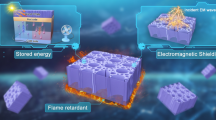Abstract
The zinc hydroxystannate/reduction graphene oxide (ZHS/RGO) hybrid was successfully prepared through the hydrothermal route, and its structure, composition and thermal properties were confirmed by XRD, FTIR, XPS, SEM, TEM, Raman spectra, and TG. ZHS/RGO hybrid is multilayer sandwich structure by morphological characterization. ZHS/RGO was applied to reduce fire hazards of epoxy (EP) as a flame retardant and smoke suppressant. The incorporation of 3.0 mass% ZHS/RGO provided fire-retardant properties to epoxy resin, testified by the results of cone calorimetry. The results indicated that ZHS/RGO can suppress the formation of smoke and toxic carbon monoxide as well as enhance the flame retardancy of the EP composites. The heat release rate, total heat release, smoke production rate, and total smoke production of EP-ZHS/RGO were greatly decreased compared with the pure EP. During the combustion process, ZHS/RGO may exhibit gaseous phase effect and condensed phase effect.






Similar content being viewed by others
References
Dikin DA, Stankovich S, Zimney EJ, Piner RD, Dommett GHB, Evmenenko G. Preparation and characterization of graphene oxide paper. Nature. 2007;448:457–60.
Guo JX, Saha P, Liang JF, Saha M, Grady BP. Multi-walled carbon nanotubes coated by multi-layer silica for improving thermal conductivity of polymer composites. J Therm Anal Calorim. 2013;113(2):467–74.
Wang X, Song L, Yang HY, Lu HD, Hu Y. Synergistic effect of graphene on antidripping and fire resistance of intumescent flame retardant poly(butylene succinate) composites. Ind Eng Chem Res. 2011;50:5376–83.
Bao X, Cai XF. Synergistic effect of methyl phenyl silicone resin and DOPO on the flame retardancy of epoxy resins. J Therm Anal Calorim. 2014;118:369–75.
Prolongo MG, Salom C, Arribas C, Masegosa RM. Influence of graphene nanoplatelets on curing and mechanical properties of graphene/epoxy nanocomposites. J Therm Anal Calorim. 2015;110:475–87.
Thomas R, Durix S, Sinturel C, Omonov T, Goossens S, Groeninckx G, Moldenaers P, Thomas S. Cure kinetics, morphology and miscibility of modified DGEBA-based epoxy resin: effects of a liquid rubber inclusion. Polymer. 2007;48:1695–710.
Song PA, Zhu Y, Tong LF, Fang ZP. C-60 reduces the flammability of polypropylene nanocomposites by in situ forming a gelled-ball network. Nanotechnology. 2008;19:22–34.
Beyer G. Short communication: carbon nanotubes as flame retardants for polymers. Fire Mater. 2002;26:291–3.
Cusack PA, Heer MS, Monk AW. Zinc hydroxystannate as an alternative synergist to antimony trioxide in polyester resins containing halogenated flame retardants. Polym Degrad Stab. 1997;58:229–37.
Hummers WS, Offeman RE. Preparation of graphitic oxide. J Am Chem Soc. 1958;80:1339.
Zhang H, Lv XJ, Li YM, Wang Y, Li JH. P25-graphene composite as a high performance photocatalyst. ACS Nano. 2010;4:380–6.
Fan XB, Peng WC, Li Y, Li XY, Wang SL, Zhang GL, Zhang FB. Deoxygenation of exfoliated graphite oxide under alkaline conditions: a green route to graphene preparation. Adv Mater. 2008;20:4490–3.
Stankovich S, Dikin DA, Piner RD, Kohlhaas KA, Kleinhammes A, Jia Y, Wu Y, Nguyen ST, Ruoff RS. Synthesis of graphene-based nanosheets via chemical reduction of exfoliated graphite oxide. Carbon. 2007;45:1558–65.
Zhong SL, Xu R, Wang L, Li Y, Zhang LF. CuSn(OH)6 sub microspheres: room-temperature synthesis, growth mechanism, and weak antiferromagnetic behavior. Mater Res Bull. 2011;46:2385–91.
Hontoria-Lucas C, Lopez-Peinado AJ, López-González JD, Rojas-Cervantes ML, Martín-Aranda RM. Study of oxygen-containing groups in a series of graphite oxides: physical and chemical characterization. Carbon. 1995;33:1585–92.
Velu S, Suzuki K, Okazaki M, Osaki T, Tomura S, Ohashi F. Synthesis of new Sn-incorporated layered double hydroxides and their thermal evolution to mixed oxides. Chem Mater. 1999;11:2163–72.
Dang TT, Pham VH, Hur SH, Kim EJ, Kong BS, Chung JS. Superior dispersion of highly reduced graphene oxide in N,N-dimethylformamide. J Colloid Interface Sci. 2012;376:91–6.
Pham VH, Dang TT, Cuong TV, Hur SH, Kong BS, Kim EJ, Chung JK. Synthesis of highly concentrated suspension of chemically converted graphene in organic solvents: effect of temperature on the extent of reduction and dispersibility. Korean J Chem Eng. 2012;29:680–5.
Niyogi S, Bekyarova E, Itkis ME, Zhang H, Shepperd K, Hicks J, Sprinkle M, Berger C, Lau CN, deHeer WA, Conrad EH, Haddon RC. Spectroscopy of covalently functionalized graphene. Nano Letter. 2010;10:4061–6.
Wang GX, Yang J, Park J, Gou XL, Wang B, Liu H. Facile synthesis and characterization of graphene nanosheets. J Phys Chem C. 2008;112:8192–5.
Kim J, Lee JH, Kim S. Estimating the fire behavior of wood flooring using a cone calorimeter. J Therm Anal Calorim. 2012;110:677–83.
Xu Q, Majlingova A, Zachar M, Jin C, Jiang Y. Correlation analysis of cone calorimetry test data assessment of the procedure with tests of different polymers. J Therm Anal Calorim. 2012;110:65–70.
Tsai KC, Kuan CF, Chen CH, Kuan HC, Hsu SW, Lee FM, Chiang CL. Study on thermal degradation and flame retardant property of halogen-free polypropylene composites using XPS and cone calorimeter. J Appl Polym Sci. 2013;127:1084–91.
Bao CL, Song L, Xing WY, Yuan BH, Wilkie C, Huang A, Guo JL, Hu Y. Preparation of graphene by pressurized oxidation and multiplex reduction and its polymer nanocomposites by masterbatch-based melt blending. J Mater Chem. 2012;22:6088–96.
Feng J, Hao J, Du J, Yang R. Using TGA/FTIR TGA/MS and cone calorimetry to understand thermal degradation and flame retardancy mechanism of polycarbonate filled with solid bisphenol A bis(diphenyl phosphate) and montmorillonite. Polym Degrad Stab. 2012;97:605–14.
Acknowledgements
This work was financially supported by the National Natural Science Foundation of China (Nos. 21306035 and 21276059) and the Key Basic Research Project of Hebei Province (No. 16961402D).
Author information
Authors and Affiliations
Corresponding author
Rights and permissions
About this article
Cite this article
Liu, X., Wu, W., Qi, Y. et al. Synthesis of a hybrid zinc hydroxystannate/reduction graphene oxide as a flame retardant and smoke suppressant of epoxy resin. J Therm Anal Calorim 126, 553–559 (2016). https://doi.org/10.1007/s10973-016-5516-5
Received:
Accepted:
Published:
Issue Date:
DOI: https://doi.org/10.1007/s10973-016-5516-5




